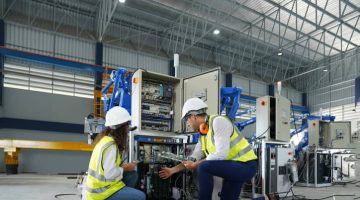Written by: Eric Whitley
Takt Time, in the context of Lean Manufacturing, is the rate at which products must be made in a process to meet customer demand.
Originating from the German word “Takt,” which means “rhythm” or “meter,” Takt Time is deeply rooted in the idea of creating a harmonious production pace. It aligns with the efficiency-focused principles of Lean Manufacturing by minimizing waste and optimizing resource utilization.
Takt Time is a tool that helps operators and engineers in chemical facilities streamline processes, reduce overproduction, and ensure that the production rate precisely meets customer demand.
Calculating the Ideal Takt Time
Calculating Takt Time is a straightforward process, vital for a sustainable production pace in chemical processing.
The formula for Takt Time calculation is the available production time divided by customer demand. This formula helps in setting a realistic and efficient pace for production, ensuring that the output aligns with market needs without compromising safety or quality.
Customer demand is a dynamic variable. For chemical processing facilities, this involves understanding the market requirements for specific chemicals, which can fluctuate due to factors like seasonal demand, industrial trends, and global supply chain shifts.
Measuring the available production time involves quantifying the total time available for manufacturing within a specific period, usually a day. In chemical processing facilities, production times can be impacted by factors like equipment maintenance, shift patterns, and safety protocols, making it essential to account for these nuances in Takt Time calculations.
Implementing Takt Time in Manufacturing Processes
Preparing for Takt Time implementation involves a thorough assessment of the current production processes. This means understanding every stage of their processes, and ensuring that the implementation of Takt Time is feasible and beneficial.
Evaluating current manufacturing processes is essential before implementation. It requires a critical assessment of the existing workflow, focusing on identifying areas of inefficiency or waste and proposing potential improvements.
Identifying bottlenecks and inefficiencies is also important in optimizing Takt Time. For chemical processing facilities, this might involve pinpointing stages in the production line where delays frequently occur due to equipment limitations, process complexities, or human factors.
Aligning workforce and machinery with Takt Time is about ensuring that both human and mechanical resources are utilized effectively. In the context of chemical processing, this means scheduling shifts and machinery operation in a way that supports a steady production flow, matching the Takt Time to avoid overstrain or underutilization.
Balancing workstations for an even flow is especially significant in chemical processing, where different stages of production might have varying complexities and time requirements.
Adjusting for variability and unexpected challenges is integral to maintaining an ideal Takt Time. This might mean having contingency plans for supply chain disruptions, equipment malfunctions, or sudden shifts in market demand.
Monitoring and Maintaining Optimal Takt Time
Continuous monitoring techniques are essential to ensure adherence. Operators in chemical processing facilities can employ real-time tracking systems to monitor production flow, using data to quickly identify and rectify deviations from the set pace.
Tracking production against Takt Time requires regularly comparing actual production rates with the set Takt Time goals. For chemical manufacturing professionals, this means using monitoring tools to ensure that each phase of production is keeping up, allowing for timely interventions in case of discrepancies.
Using data analytics for real-time adjustments enables operators to quickly identify trends, predict potential bottlenecks, and make informed decisions to keep the production line running smoothly and efficiently.
Upgrading processes and technology is essential for staying efficient in the long term. This could involve anything from investing in advanced automation and refining production techniques to implementing more sophisticated demand forecasting tools — all aimed at enhancing productivity and responsiveness.
Overcoming Common Challenges
Addressing misalignments and delays in the production process is crucial for adhering to Takt Time. Chemical processing facilities face unique challenges in this regard, often needing to fine-tune equipment, adjust workflows, or provide additional training to staff to ensure smooth and timely production flows.
Managing the demand and supply chain issues requires agility and foresight. Chemical processing operations are often at the mercy of volatile market and supply conditions, which is why they need robust planning and flexible production capabilities to swiftly adjust to these changes without compromising on efficiency.
Overcoming cultural and organizational challenges often requires building a culture of continuous improvement, educating teams about the benefits of Takt Time, and fostering collaboration across different departments to achieve smooth and efficient production.
Conclusion
Integrating Takt Time effectively into manufacturing processes offers significant benefits, especially in the chemical processing industry. It promotes efficiency, aligns production with market demand, and can lead to significant cost savings and environmental benefits.
The role of Takt Time in the future of Lean Manufacturing cannot be overstated. As industries like chemical processing continue to evolve, embracing Takt Time will be key in maintaining competitive and efficient operations, especially with increasingly dynamic and demanding markets and customer expectations.
 Bio: For over 30 years, Eric Whitley has been a noteworthy leader in the manufacturing space. In addition to the many publications and articles Eric has written on various manufacturing topics, you may know him from his efforts leading the Total Productive Maintenance effort at Autoliv ASP or from his involvement in the Management Certification programs at The Ohio State University, where he served as an adjunct faculty member.
Bio: For over 30 years, Eric Whitley has been a noteworthy leader in the manufacturing space. In addition to the many publications and articles Eric has written on various manufacturing topics, you may know him from his efforts leading the Total Productive Maintenance effort at Autoliv ASP or from his involvement in the Management Certification programs at The Ohio State University, where he served as an adjunct faculty member.
After an extensive career as a reliability and business improvement consultant, Eric joined L2L, where he currently serves as the Director of Smart Manufacturing. His role in this position is to help clients learn and implement L2L’s pragmatic and simple approach to corporate digital transformation.
Eric lives with his wife of 35 years in Northern Utah. When Eric is not working, he can usually be found on the water with a fishing rod in his hands.



